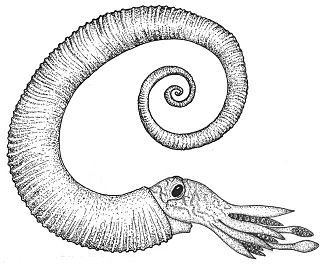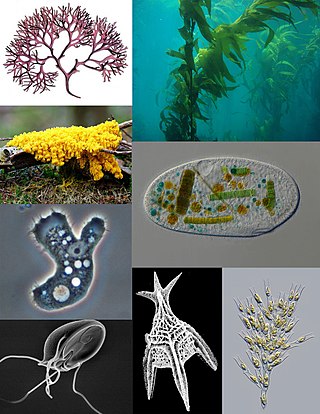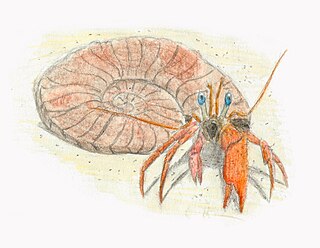
Ammonoids are a group of extinct marine mollusc animals in the subclass Ammonoidea of the class Cephalopoda. These molluscs, commonly referred to as ammonites, are more closely related to living coleoids than they are to shelled nautiloids such as the living Nautilus species. The earliest ammonites appeared during the Devonian, with the last species vanishing during or soon after the Cretaceous–Paleogene extinction event.
Paracimexomys is a genus of extinct mammals in the also extinct Multituberculata order. Paracimexomys lived during the Cretaceous period. The few fossils remains come from North America. Some Romanian fossils were also tentatively assigned to this genus, though that classification now seems doubtful.

The Ancyloceratina were a diverse suborder of ammonite most closely related to the ammonites of order Lytoceratina. They evolved during the Late Jurassic but were not very common until the Cretaceous period, when they rapidly diversified and became one of the most distinctive components of Cretaceous marine faunas. They have been recorded from every continent and many are used as zonal or index fossils. The most distinctive feature of the majority of the Ancyloceratina is the tendency for most of them to have shells that are not regular spirals like most other ammonites. These irregularly-coiled ammonites are called heteromorph ammonites, in contrast to regularly coiled ammonites, which are called homomorph ammonites.

Wastebasket taxon is a term used by some taxonomists to refer to a taxon that has the purpose of classifying organisms that do not fit anywhere else. They are typically defined by either their designated members' often superficial similarity to each other, or their lack of one or more distinct character states or by their not belonging to one or more other taxa. Wastebasket taxa are by definition either paraphyletic or polyphyletic, and are therefore not considered valid taxa under strict cladistic rules of taxonomy. The name of a wastebasket taxon may in some cases be retained as the designation of an evolutionary grade, however.
Chiayusaurus is a genus of sauropod dinosaur known from teeth found in China and possibly also South Korea. Two species have been named for this obscure genus, though only the type, C. lacustris, is still seen as valid. It was originally named as Chiayüsaurus, but the ICZN does not permit special characters, so the name was corrected to Chiayusaurus. The obsolete name can still be seen in older sources, though. As a sauropod, Chiayusaurus would have been a large, quadrupedal herbivore.

Obinautilus is an extinct genus of shelled cephalopod that has been variously identified as an argonautid octopod or a nautilid. It is known from the Late Oligocene to Pliocene of Japan. The shell is discoidal and very involute, with rapidly expanding and compressed whorls, fine radial ribs, a rounded venter with a shallow furrow, and almost closed umbilicus.

Ancyloceras is an extinct genus of heteromorph ammonites found throughout the world during the Lower Cretaceous, from the Lower Barremian epoch until the genus extinction during the Lower Aptian.

Chenanisuchus is a genus of dyrosaurid crocodyliform from the Late Cretaceous of Mali and the Late Palaeocene of Sidi Chenane in Morocco. It was described in 2005, after expeditions uncovered it in 2000.
Anisoceratidae is an extinct family of heteromorph ammonites which belong to the Ancyloceratina superfamily Turrilitoidea. Members of the family range is from the lower Albian to the upper Turonian. The family is possibly derived from a member of the Hamitidae.

Turrilitidae is a family of extinct heteromorph ammonite cephalopods. All members had shells that coiled helically that tended to resemble auger shells. The ecological roles turrilitids played is largely unknown, as experts are still speculating what niches they filled. Some are suspected of floating in the water column, while others, such as the eponymous Turrilites, are believed to have been bottom-dwellers. The name of the type genus Turrilites is a hybrid formation based on Latin turris "tower" and Greek lithos "stone", coined by Lamarck in 1801.

Nostoceratidae is a diverse family of heteromorph ammonites found throughout the oceans of the world during the Late Cretaceous. The nostoceratids are famous for the bizarre coiling of their shells. Many genera, such as Yezoceras, Ainoceras, Anaklinoceras, and some species of Bostrychoceras and Eubostrychoceras, display, as young shells at least, a helical coiling very similar to the shells of the related family, Turrilitidae. As adults, though, the coils then curve away from the axis of coiling, either as an oxbow-like curve around the juvenile coils as in Ainoceras and Anaklinoceras, or in a simple curved loop beneath the juvenile coils, as in Yezoceras. Other genera form loose coils, sometimes in a spiral, such as those of Madagascarites, Muramotoceras, Hyphantoceras, and the infamously convolute Nipponites.

Palaeopagurus is an extinct genus of hermit crab from the Lower Cretaceous.

Lacusovagus is a genus of azhdarchoid pterodactyloid pterosaur from the Lower Cretaceous of Brazil. It is based on SMNK PAL 4325, a partial upper jaw comprising sections of the skull in front of the eyes. This specimen was found in rocks of the Early Cretaceous-age Nova Olinda Member of the Crato Formation. The skull was long, and unusually wide. The section in front of the combined nasal-antorbital fenestra was relatively short. Also unusual was the combination of its toothless jaws and no bony head crest. Lacusovagus was described in 2008 by Mark Witton. The type species is L. magnificens, meaning "grand lake wanderer", in reference to its large size—it is currently the largest pterosaur known from the Crato Formation with an estimated wingspan of approximately 4 metres (13 ft) and a body mass of 30 kg (66 lb).

Shinisauria is a clade or evolutionary grouping of anguimorph lizards that includes the living Chinese crocodile lizard Shinisaurus and several of its closest extinct relatives. Shinisauria was named in 2008 by Jack Lee Conrad as a stem-based taxon to include all anguimorphs more closely related to Shinisaurus than to Anguis fragilis, Heloderma suspectum or Varanus varius. Several recent phylogenetic analyses of lizard evolutionary relationships place Shinisauria in a basal position within the clade Platynota, which also includes monitor lizards, helodermatids, and the extinct mosasaurs. Shinisaurians were once thought to be closely related to the genus Xenosaurus, but they are now considered distant relatives within Anguimorpha. The fossil record of shinisaurians extends back to the Early Cretaceous with Dalinghosaurus, which is from the Aptian aged Yixian Formation of China. Two other extinct shinisaurians are currently known: Bahndwivici from the Eocene of Wyoming and Merkurosaurus from the Late Oligocene of Germany and the Early Miocene of the Czech Republic. An indeterminate shinisaurian is known from an isolated tail found in the Eocene aged Messel pit in Germany.
This list, 2013 in molluscan paleontology, is a list of new taxa of ammonites and other fossil cephalopods, as well as fossil gastropods, bivalves and other molluscs that have been described during the year 2013.
Groenlandibelidae is a family of coleoid cephalopods believed to belong to the spirulids.
Varavudh Suteethorn, or Warawut Suteethorn is a Thai palaeontologist and geologist. He is the current director of the Palaeontological Research and Education Centre, Mahasarakham University. He is best known for his work on vertebrate paleontology in northeastern Thailand, having contributed to the discovery of many fossil taxa and dig sites in the Khorat Plateau, as a part of a long-standing collaboration between Thai and French scientists.
Acrorhizodus is an extinct genus of hybodont shark currently containing only the species: Acrorhizodus khoratensis. It is known from the Albian to Aptian aged Khok Kruat formation of the Khok Pha Suam locality near the town of Sri Muang Mai, Thailand. It displays a mix of features which sets it apart from all hybodont families currently known.
This list of fossil molluscs described in 2021 is a list of new taxa of fossil molluscs that were described during the year 2021, as well as other significant discoveries and events related to molluscan paleontology that occurred in 2021.

Macroscaphitidae is an extinct family of ptychoceratoid cephalopods from the subclass Ammonoidea that lived from the Lower Barremian to the Lower Cenomanian stages of the Cretaceous. Fossils of Macroscaphitidae were found all around the world although the abundance of found fossils is rather limited. Known fossils from collections were found largely in Europe, South America and Africa. It is known for some species of which complete specimens were found that these animals developed a hetermorphic shell, i.e. the coiling of the shell was not regular, such that the first whirls formed a planispirally coiled evolute section as seen in homomorphic ammonites, but had an additional straight middle part and a presumably upwards facing aperture. Due to their odd morphology the taxonomic classification of Macroscaphitidae changed often over time since their discovery and may not be finally settled even now.













